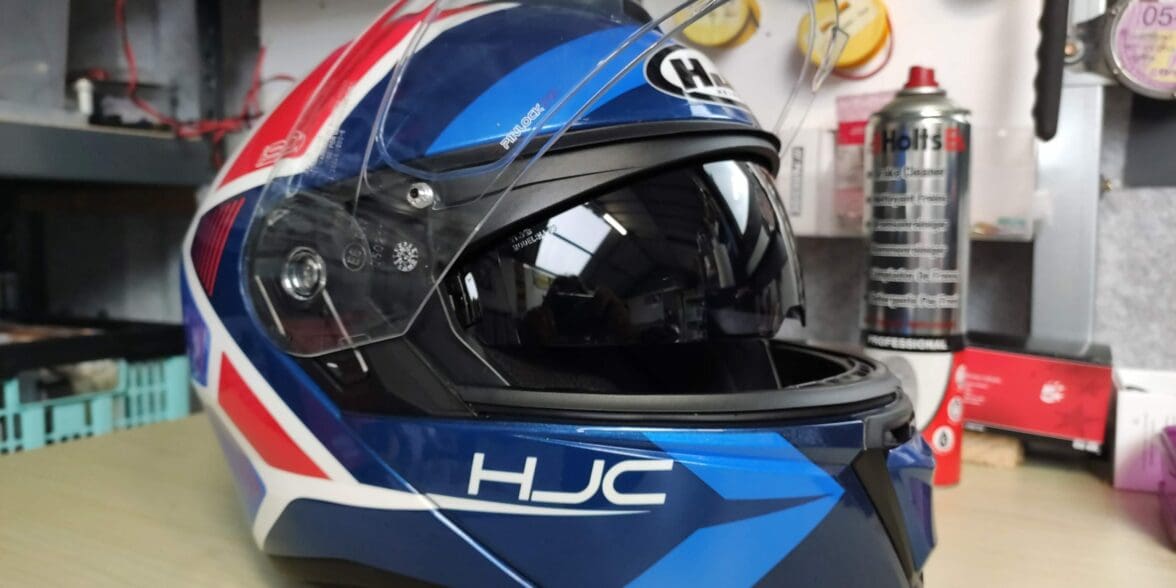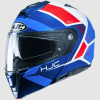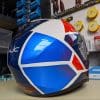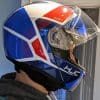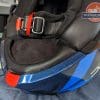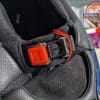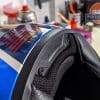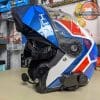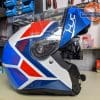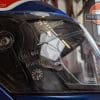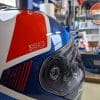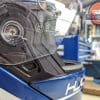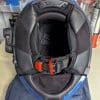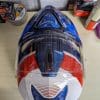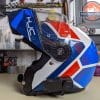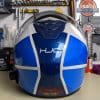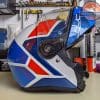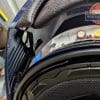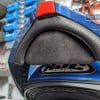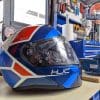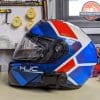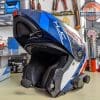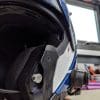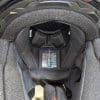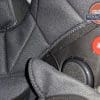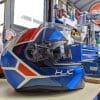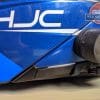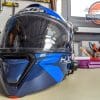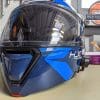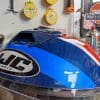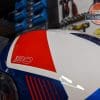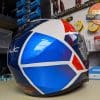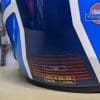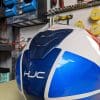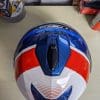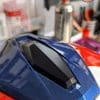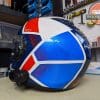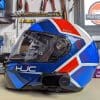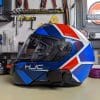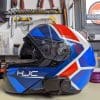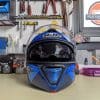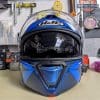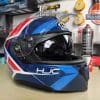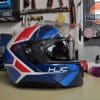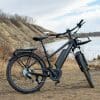Years ago, the field of modular helmets seemed like a distant cousin of the world of full-face lids. Modular lids were noticeably larger, as heavy as an anvil, and about as stylish. Chinbars flopped about seeming more like a loosely fitted accessory than an integral part of the helmet. Apart from very expensive offerings from Schubert (who also made many BMW-branded lids), you were usually better off with even a cheaper full-face lid.
Thankfully, this has all changed and HJC, along with the likes of Caberg and Nolan, has been at the forefront of overhauling this segment of the helmet market over the last ten years. You might be forgiven for not hearing of the latter two marques, both of which are Italian, but you’ve probably encountered HJC before – the Korean brand proclaims itself to be “number one in the world”, manufacturing over a million helmets a year between their South Korean and Vietnamese factories, sponsoring various top-level racers in various categories making themselves into a well-established global brand. Releasing the HJC i90 in 2020, as a successor to the IS-Max II, you get a polycarbonate flip-up homologated for use in the open or closed position, internal sun visor, Pinlock anti-fog layer for your visor, chin curtain, speaker, and glasses cutouts in the liner, decent vents, and a nice paint job for somewhere around $220/€220, depending on retailer and color options.
I bought one in February and have been using it as my primary lid, enjoying the benefits of being able to flip up the front of the helmet in low-speed conditions. Is it worth the money? If you can only have one helmet, will this do the trick? Read on to find out.
The Shape
HJC claims the i90 to be an intermediate-oval shape, and so it should suit most riders. As a comparison, I have previously worn a Duchinni D801, a Shark S900, a Shoei XR1100, and a Shark Skwal. The fit of the HJC i90 is quite close to both Sharks and the Shoei with it erring on the side of the sport in the sport-touring mix.
The Exterior
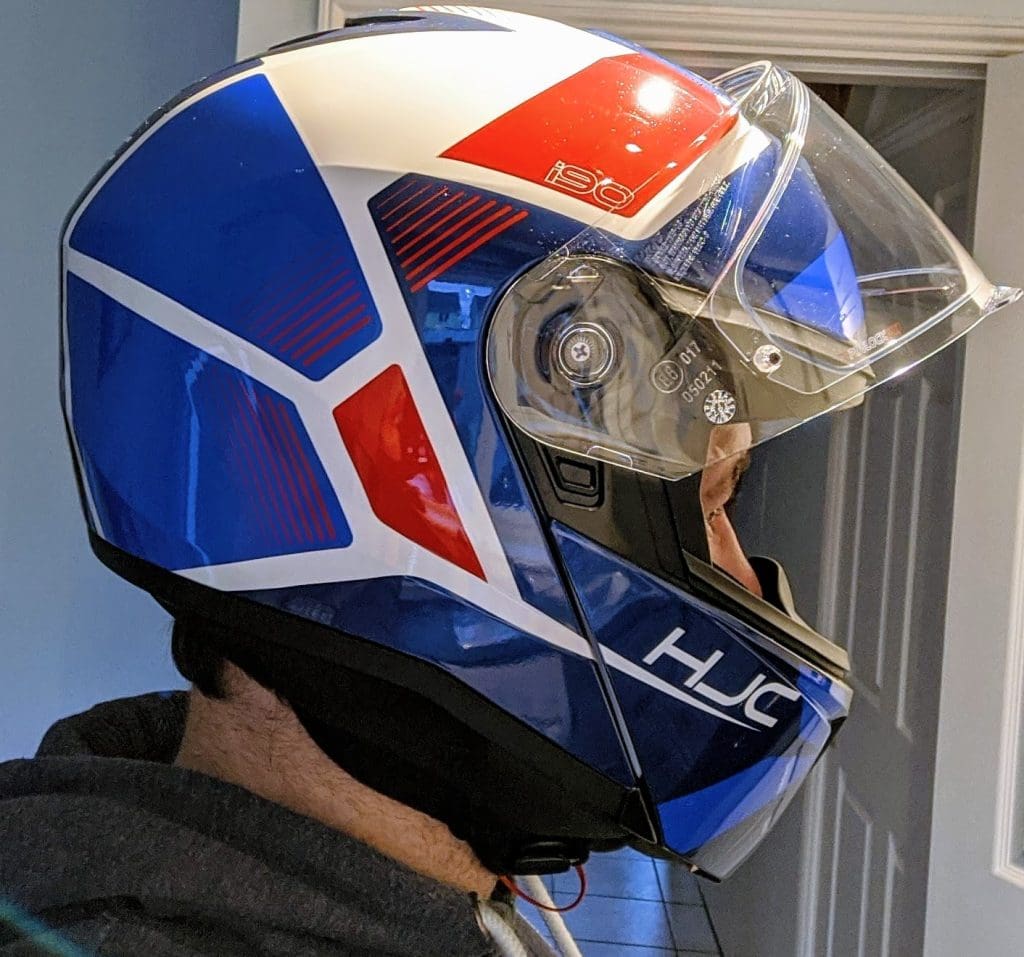
According to HJC each of their helmets is, essentially, handmade in a 40-step process but that’s easy to say when polycarbonate helmets can be made in a mold rather than having to manually layer sections of fiberglass and resin. That said, there’s nothing inherently wrong with a polycarbonate shell.
While it may not be as hard or as light as similar fiberglass, or carbon fiber shell, it meets the same criteria and arguments have been made about how, in some cases, it can actually protect your head a little better than overly hard fiberglass shells as the softer polycarbonate cushions and compresses rather than deflects (for more on this seek out Dexter Ford’s article “Blowing the Lid Off” from Motorcyclist Magazine circa 2005 and a follow up in the New York Times from 2009).
For clarity, Ford’s article references an older Snell standard, although a recent video by Youtuber Fortnine presents a similar argument for the current Snell standard, with both arguing that it favors harder helmets than DOT or ECE standards call for. Harder helmets are not necessarily safer helmets so the point that polycarbonate helmets can be as safe, if not safer in some situations, as their more technically advanced cousins still stand. The British Department of Transport’s SHARP test, which examines helmets using 32 different impact tests, has shown that polycarbonate helmets can achieve scores on a par with fiberglass or carbon fiber helmets.
While the HJC i90 has not yet been tested by SHARP, it does meet ECE and DOT standards, and its direct predecessor, the HJC IS-MAX II scored 4 stars out of 5 and it’s chinbar remained securely locked through 100% of the tests conducted by SHARP. This bodes well for the i90 and, given the quality of the helmet, I would be very surprised if it didn’t at least match the safety performance of the IS-MAX II.
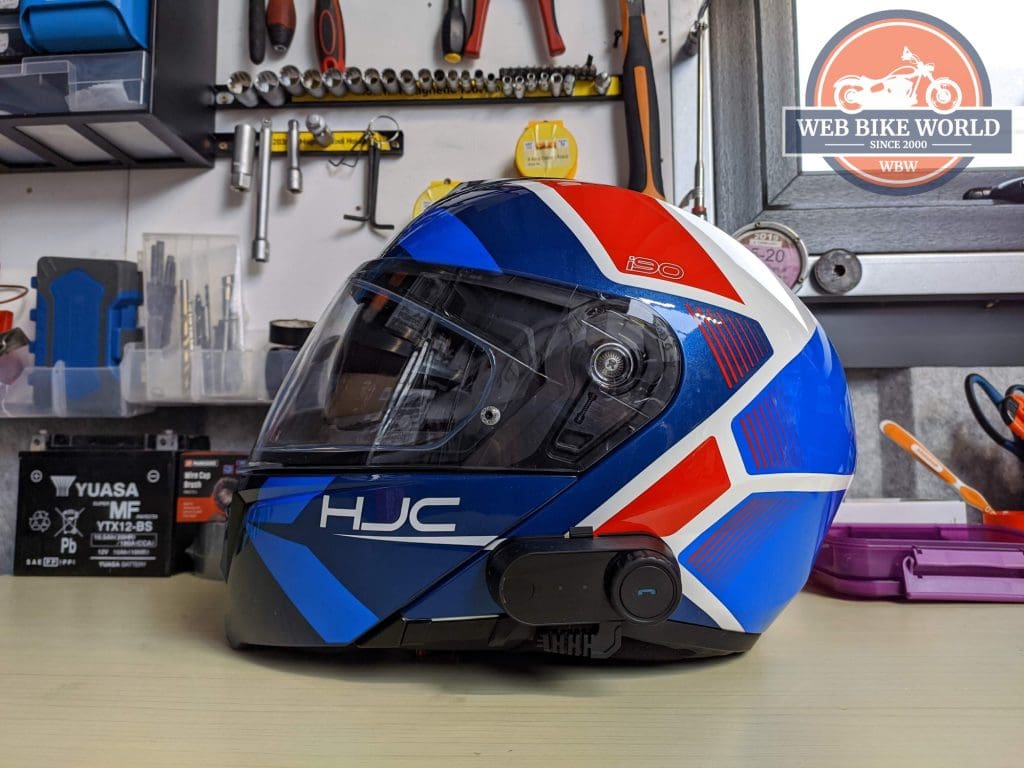
Construction Materials
It’s near impossible to tell the difference between construction materials when looking at a helmet, unless the manufacturer deliberately allows the fiber pattern to show, but you’d be hard-pressed to tell if the i90 was a polycarbonate helmet even after picking it up. At 1700g (size small) it’s not much heavier than its fancier flip-up cousin the carbon/aramid-shelled HJC RHPA 90S, with just 150g between them. That said, it’s not the lightest in its class, the similarly priced Caberg Duke II and Shark Evo ES are about 50g lighter – that’s about the weight of a Snickers bar (although you should check this, they tend to shrink every year).
Obviously, all of these are heavier than an equivalent-sized full-face lid with my old polycarbonate Shark Skwal weighing in at 1400g (size small), but I can’t say my neck has noticed much of a difference! Its relatively lightweight nature can be accounted for by its compact size. It’s no bigger than that full-faced Shark Skwal when put side by side, probably as a result of HJC using three different shell sizes for the i90 which should ensure a better fit for most people.
One shell is used for XS and S, another for M and L, and another for XL – XXXL (you can even go as large as 5XL in the US, although 3XL-5XL sizes are DOT approved only and are not available in Europe). The spread of shell sizes is good news for those of us with smaller heads because it means we’re not lumped with a large shell that’s overloaded with padding to make it fit and thus you’re not carrying around unnecessary weight on your neck.
The Paintwork
Having picked up the helmet, you’ll notice the quality of the paintwork. There are no sticker ridges, no lacquer overrun, nothing but thickly laid, high-quality paint which you’d need a chisel to remove. It’s tough for photos to do it justice but the “Hollen” versions, and especially the Red/White/Blue version which I have, sparkle under sunlight.
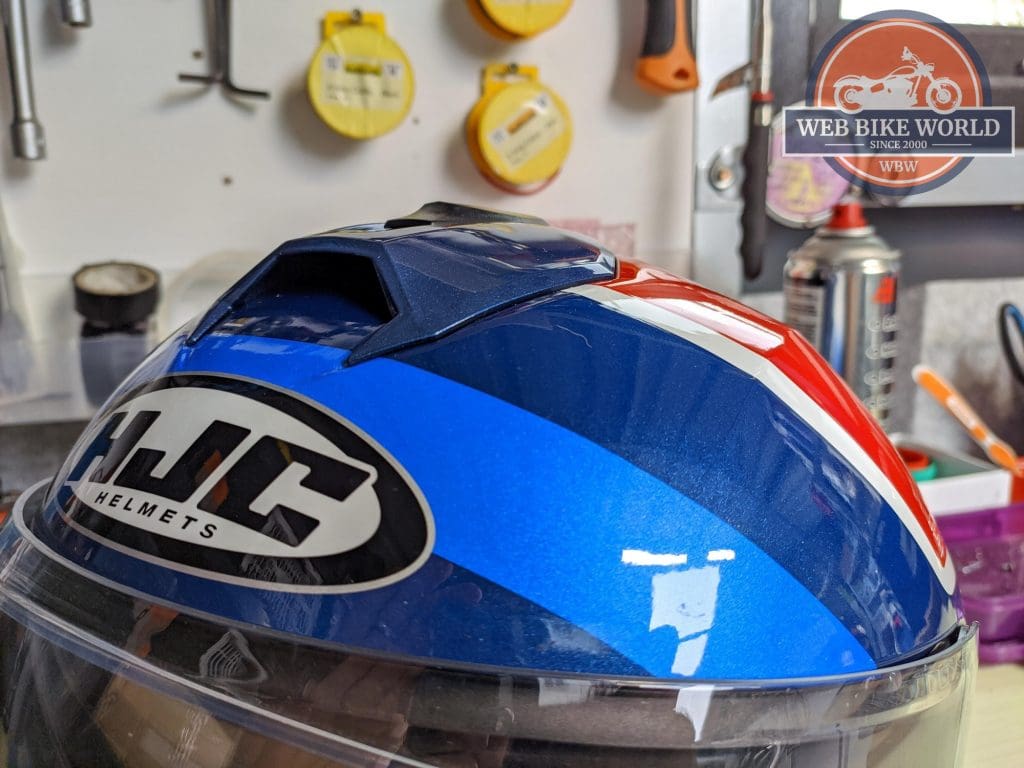
It’s the kind of paint you would expect on a much more expensive helmet and makes the i90 extremely eye-catching. It’s a real departure from the dull solid colors which adorned modular lids years ago, although HJC does warn you that the metallic sparkle will fade under strong UV light over time. How long it would take to fade is anyone’s guess but given that you should be changing your lid every 4 or 5 years, I didn’t let it influence my decision to purchase.
Vent Location
The front vents, one on the chin and one above the forehead, are well integrated and easy to operate with a gloved hand into the open or closed position. While this keeps the shell design nice and clean, especially given that the rear vents are almost embossed into the shell, other lids will give you more choice on where you want cool air to be directed.
Perhaps it’s just me but one side of my head doesn’t get noticeably warmer than the other so a strong central vent does me fine and the one on the i90 really does scoop air through and over my head while the chin vent does a good job at cooling my face and preventing the sun visor from misting.
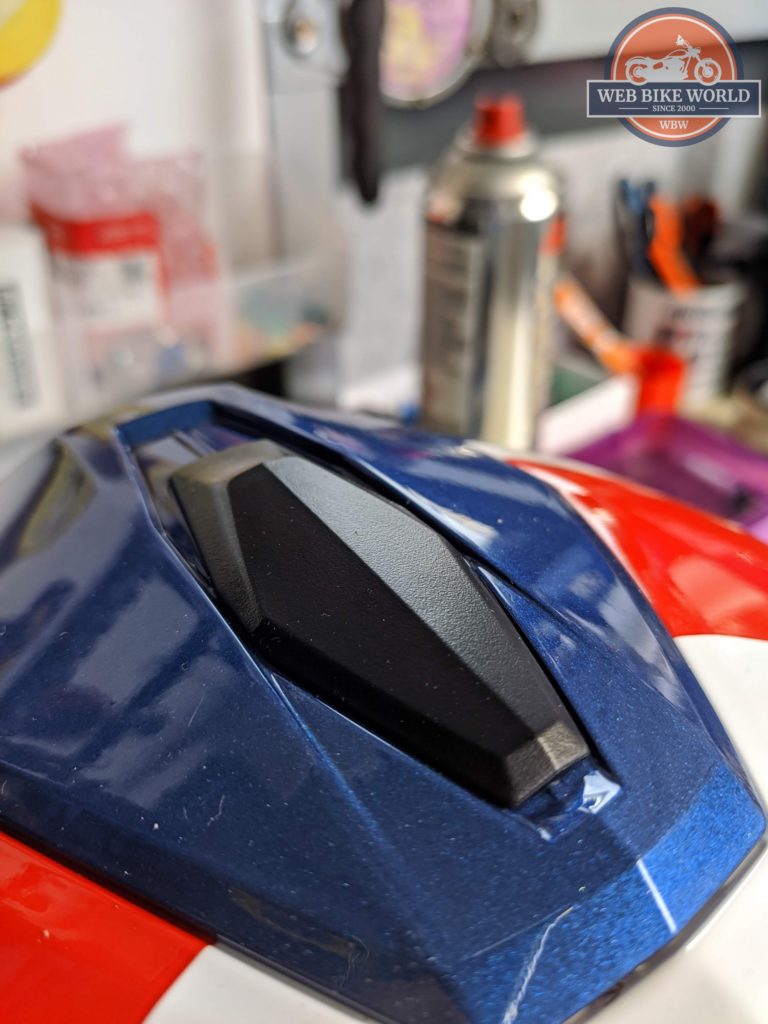 |
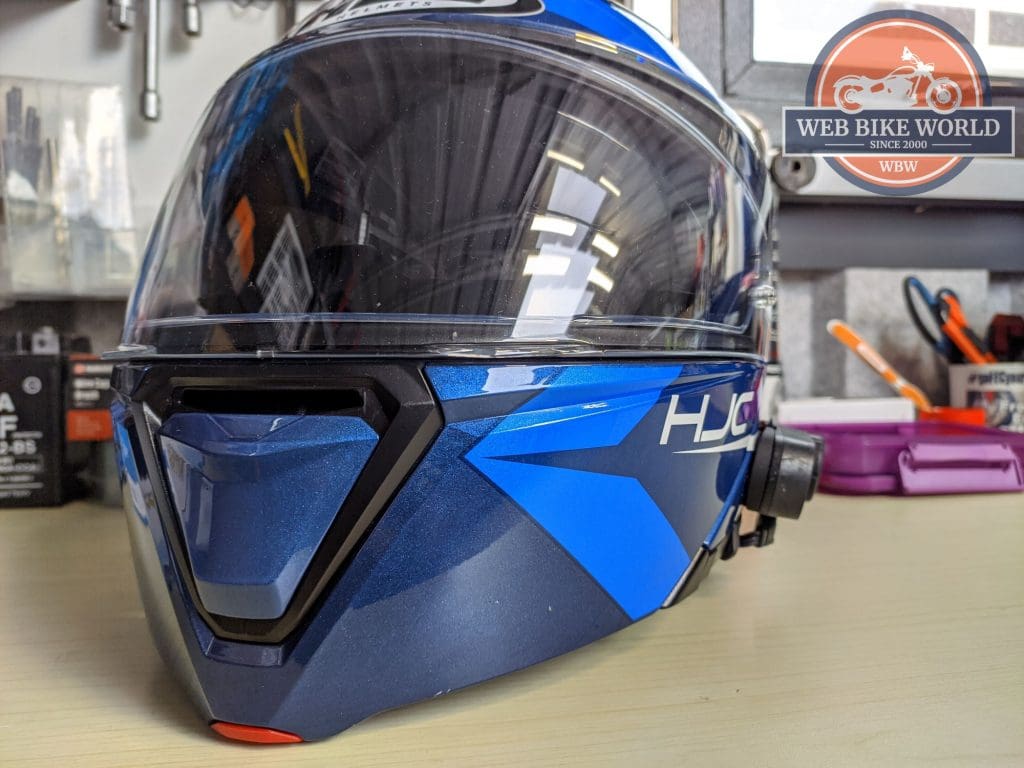 |
|---|
Large central vent switch and the large chin vent, easily used with the thickest gloves.
The Sunvisor
Unfortunately, while the vents are paragons of convenience, the switch for that sun visor is not. HJC has used a wire lever with a sliding switch on the bottom of the helmet where many people would usually fit an aftermarket intercom. LS2, amongst other brands, also mount visor switches in this annoying position. Yes, it’s certainly better than a long switch behind the top vent, something akin to attempting to scratch an itch on your back while riding your bike, but it’s the one area I feel HJC could really improve on the exterior.
While it only took a week or so to become used to the position of the switch, I don’t intuitively know when the visor is fully up or down so I end up spending an extra second or two moving the switch to be sure, attempting to feel for a little click as the visor retracts into the fully closed and secure position. It’s not the end of the world but if there’s a successor to the i90, that is one area HJC could improve.
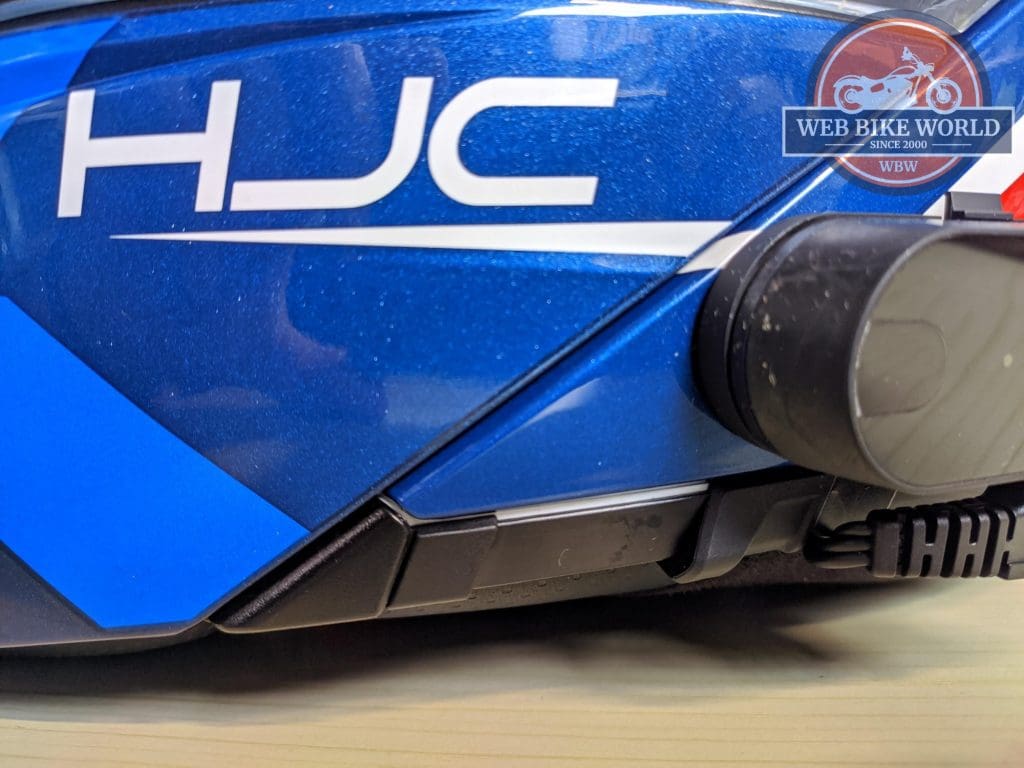
The Interior
While deep paint and a sculpted shell are nice to look at, you’ll be spending most of your time with it on your head so the interior needs to be just as good as the exterior.
Cheek Pads and Lining
Thankfully, the i90 doesn’t disappoint with a pleasantly high-end feeling to the interior of the helmet, HJC using the proprietary Coolmax anti-bacterial fabric on the headliner and cheek pads and soft faux suede on the chin curtain and strap lining. It’s a well-thought-out combination with the faux suede ensuring the helmet strap doesn’t cause irritation on your skin while the Coolmax stops the lid from becoming too smelly in the more sweat-prone areas.
Alongside that, the cheek pads drop further than I’ve noticed on most helmets, encasing the bottom of your head in an effort to prevent draughts and reduce wind noise. As you’d expect, the liners and cheek pads are all removable, washable, and replaceable. The cheek pads have a subtle curve at the top to allow space for spectacles. I find it fiddly to get glasses to fit nicely in any helmet and while the i90 remains perfectly comfortable when accommodating glasses, given a choice, I still prefer wearing contact lenses.
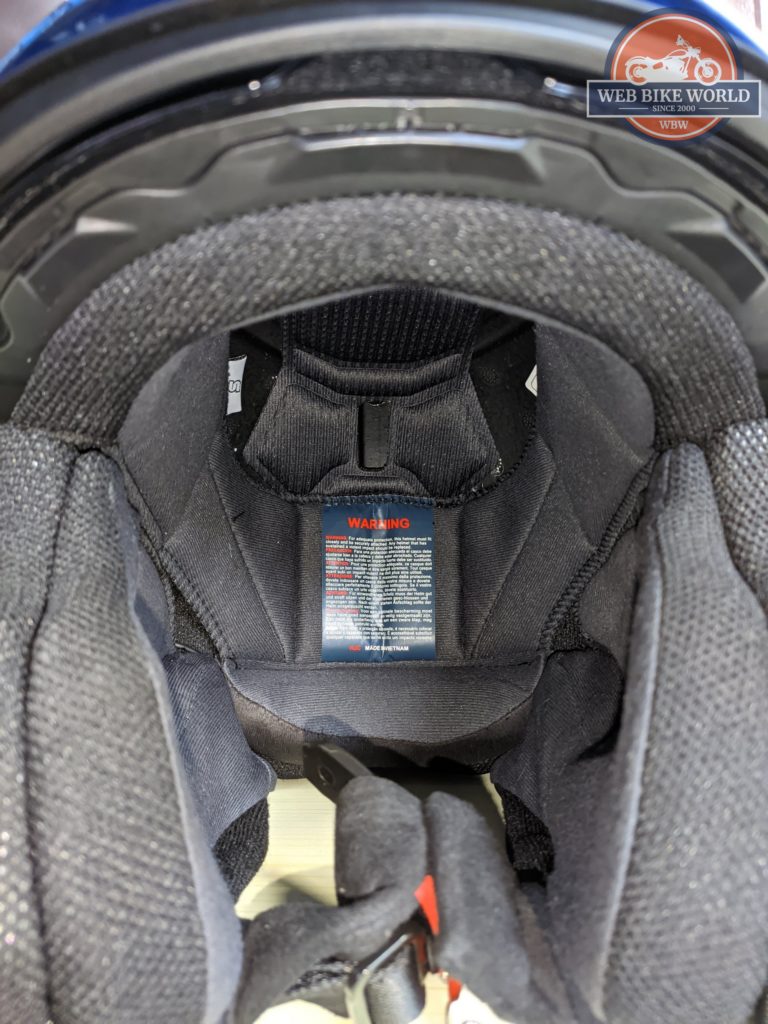 |
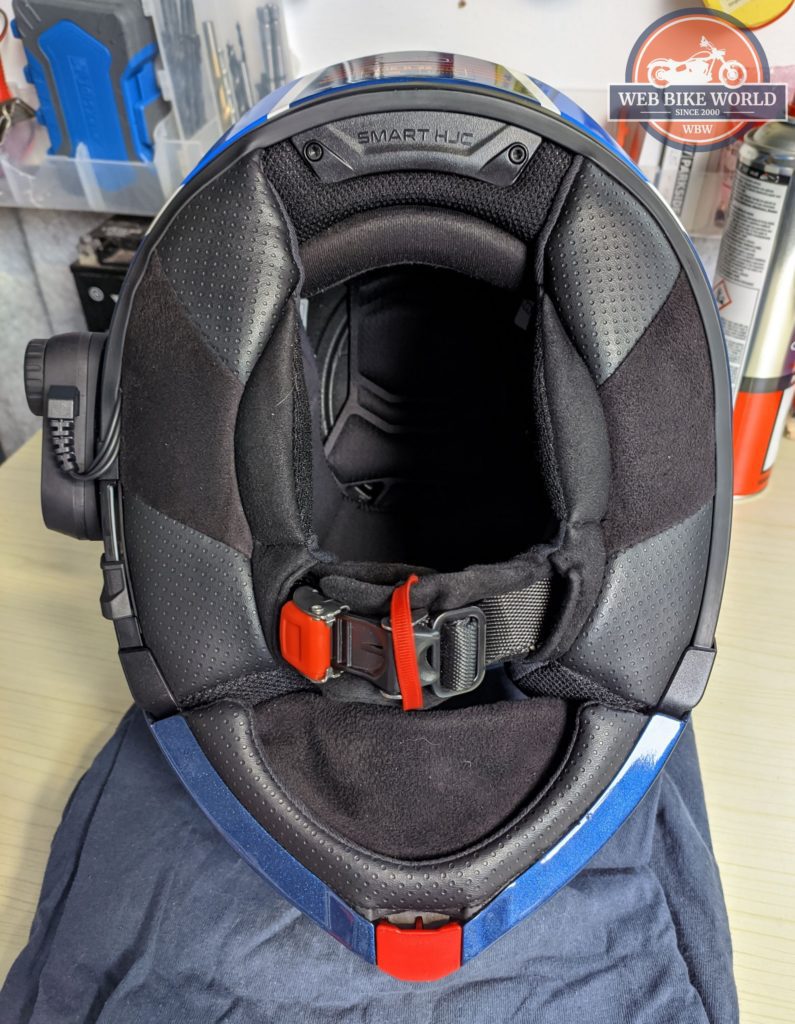 |
|---|
On the left, you can see the HJC i90 interior with the chinbar fully open. Notice the subtle curve at the top of the cheek pads to accommodate spectacles. On the right, you can see how the liner maintains a narrow aperture for your head, preventing draughts and reducing wind noise.
One of the under-appreciated advantages of a modular helmet, to this writer at least, is just how easy it is to remove and replace the pads and liners with the chin bar out of the way! These are held in place using red poppet fasteners, so they’re fairly easy to see when you’re refitting the pieces, and are very secure when fitted. With the cheek pads and headliner out of the way, there’s a decent set of speaker pockets for each ear, with just about enough space to move the speaker within the pocket to optimize the fit for your ear. HJC even embedded wire channels in the EPS to keep the wiring neat and tidy.
This detail is a result of the helmet being designed from the ground up to accommodate the HJC/Sena Communicator system. This unit clips to the side of the helmet with the battery in a little pocket under the rear of the helmet, secured by two small screws. I don’t have this piece of kit but the design of the pocket means it doesn’t look like anything is amiss – clever.
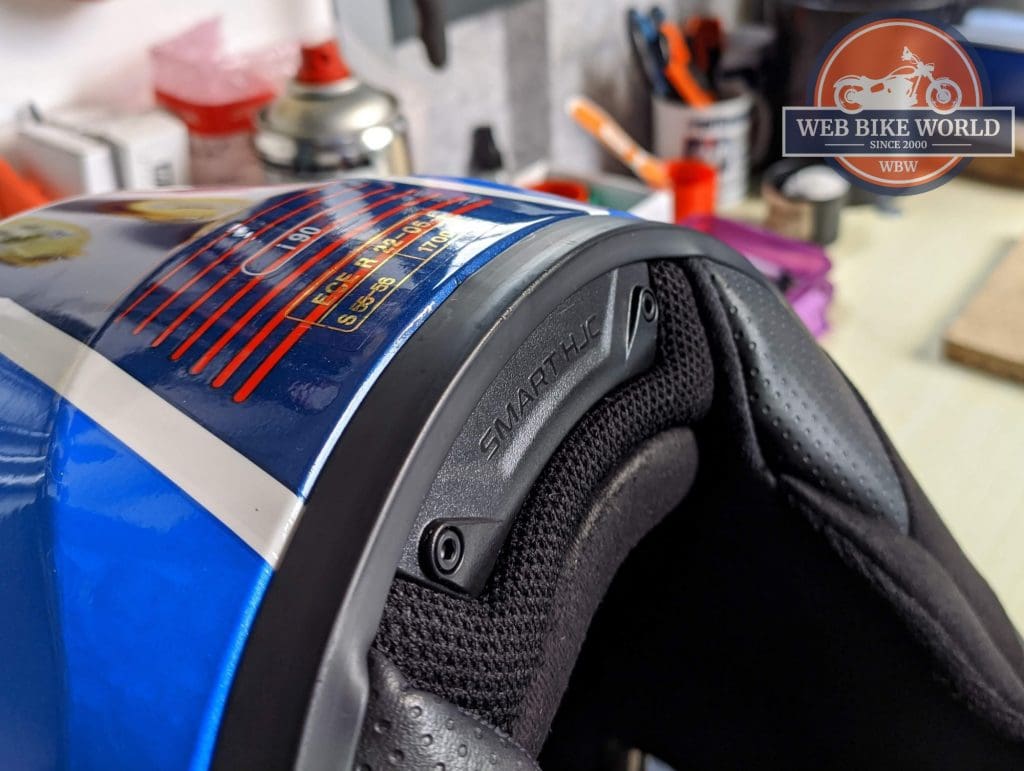
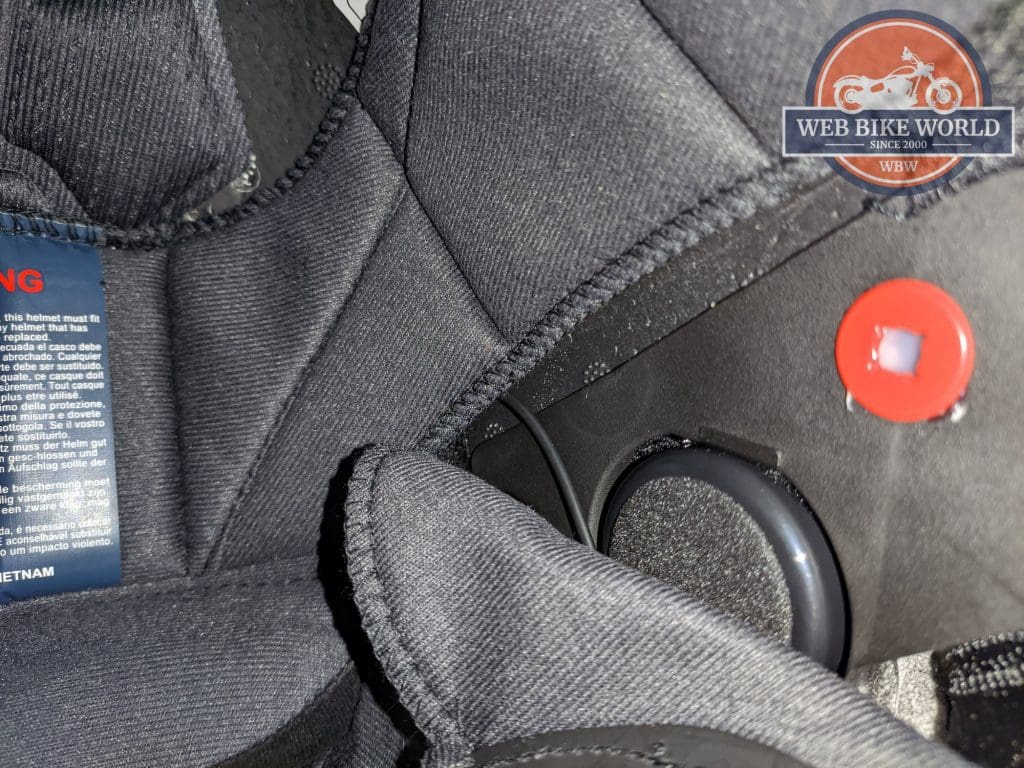
Fit and Riding Comfort
However, none of these details would matter if the helmet wasn’t a good fit. HJC claims the i90 is an intermediate oval shape, which is perhaps the most universal shape and a good target to aim for if you want to fit the most heads, most of the time. Alongside this, HJC uses three different shell sizes for the i90 which should ensure a better fit for most people. One shell is used for XS and S, another for M and L, and another for XL – XXXL (up to 5XL in the US). When I first tried it on in the shop, I was aware that it was a good deal tighter than my 5-year-old Shark Skwal, with the crown of the helmet gripping the top of my head rather than giving it a firm hug.
Sizing can be tough to interpret on a modular helmet as, when putting it on you leave the chinbar open, which naturally allows the helmet to flex a little more and accommodate your head shape but when you close the chinbar the cheek pads are pushed together making it feel tighter. Deciding that the initial tightness would dissipate with time, I purchased the helmet and then suddenly became very aware of the risk of head injuries in the home and so decided to wear it for a few hours. Ah, the things I do for bikes!
However, after about 30 minutes my head was starting to get sore and my mind was starting to wonder if I had just wasted a pile of cash. It took several hours of this kind of “in-house” testing to finally feel it loosen-up enough that it felt comfortable. I suspect that had I been able to use it while riding it would have broken in a little easier but with Ireland under a Covid-19 lockdown, I thought it was best to keep the testing inside.
Since then I’ve spent many hours on a VFR and an NT700/Deauville using this helmet in order to test it on bikes with very different riding positions and the helmet has never become uncomfortable. There are points where I’m eager to get a break from having something encasing my head but don’t necessarily want to stop the ride and that’s where the convenience of the flip-up really comes into its own.
By opening the chinbar, the cheek pads can flex and allow for a slightly looser fit but closing the chinbar brings the helmet back to a fit that, while still comfortable, is more snug and secure, and possibly more on the sporty side of the sport-touring scale. It’s an interesting sensation that you can’t replicate with a full-face lid.
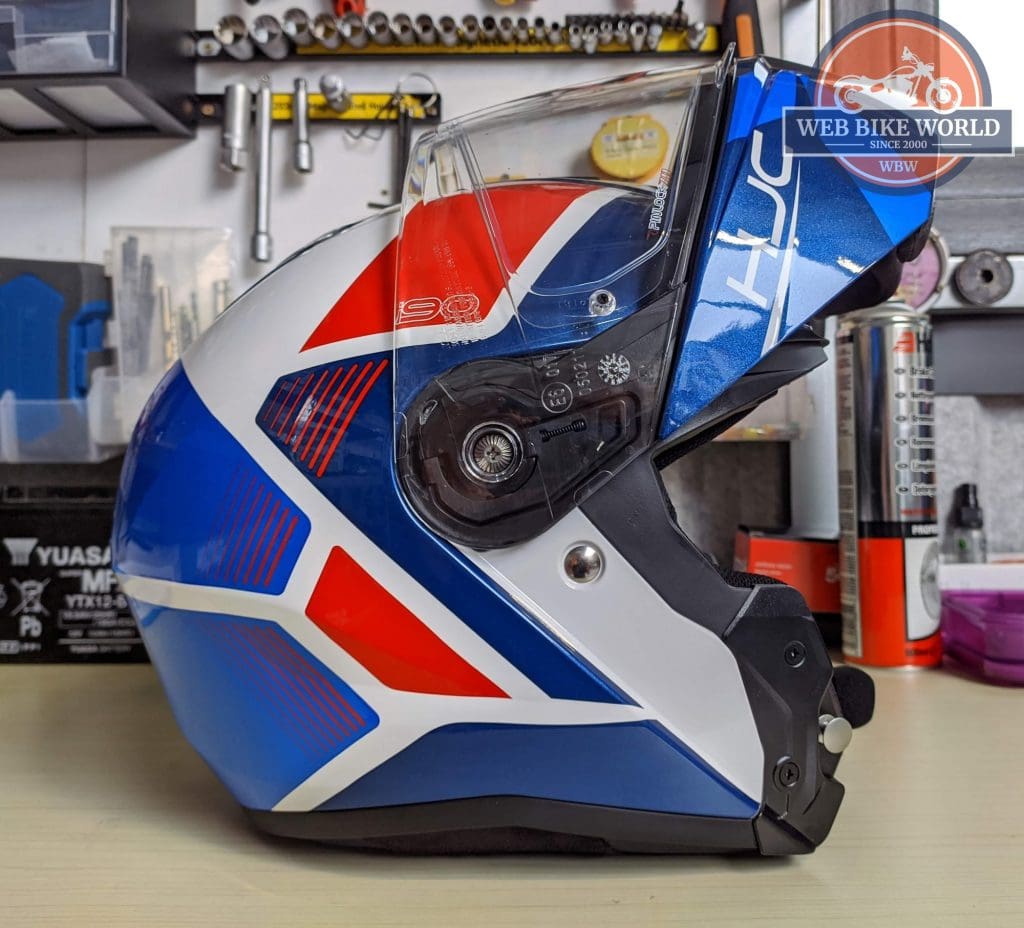
That chinbar mechanism may well be the centerpiece of the helmet because it shows just how far modular lids have come over the years. Not only is it extremely easy to use whilst on the move, you simply pull on the red toggle button under the center of the chinbar and lift it into the locked-open position, but its movement is precise and the closing mechanism feels strong. This is a result of the i90 using steel pins on the shell which the chinbar fastens to upon closing.
The precision of that mechanism means that, with the helmet on your head, there’s little to no movement between the chinbar and the rest of the helmet, although, the helmet does tend to emit the odd plasticky creak a bit when you are moving it about, for example, to remove the visor. This is a combination of other plastics, such as vents or liner fastenings, moving slightly and inherent flex in the chinbar. I’m nitpicking here, none of this is noticeable with the helmet on.
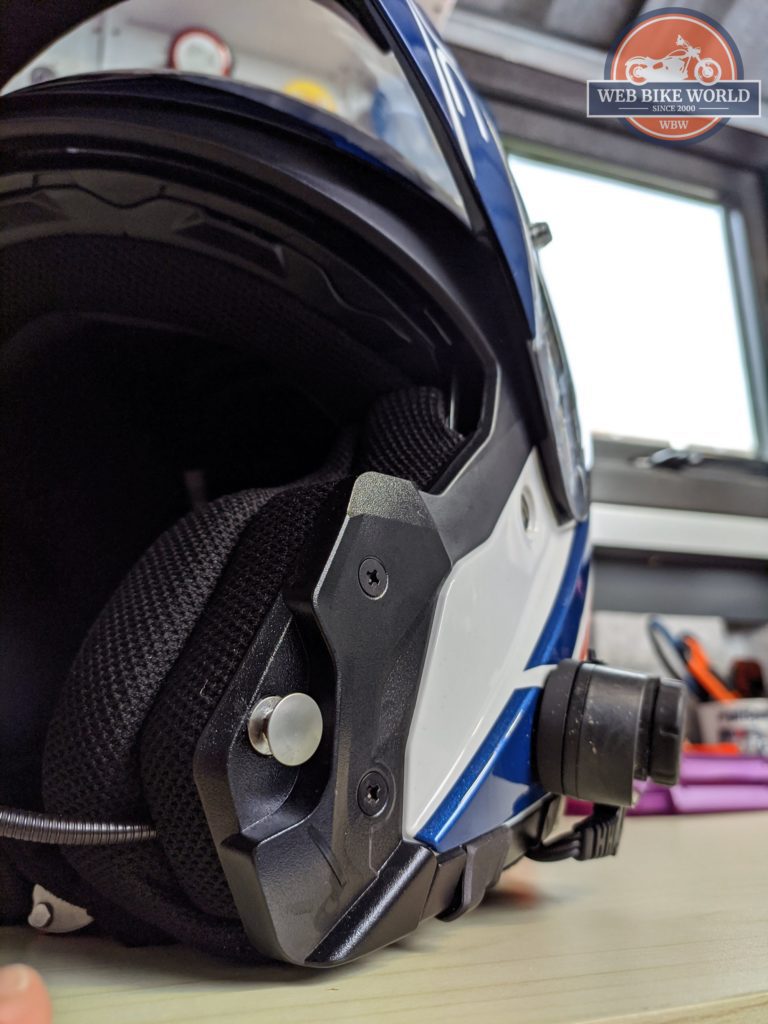 |
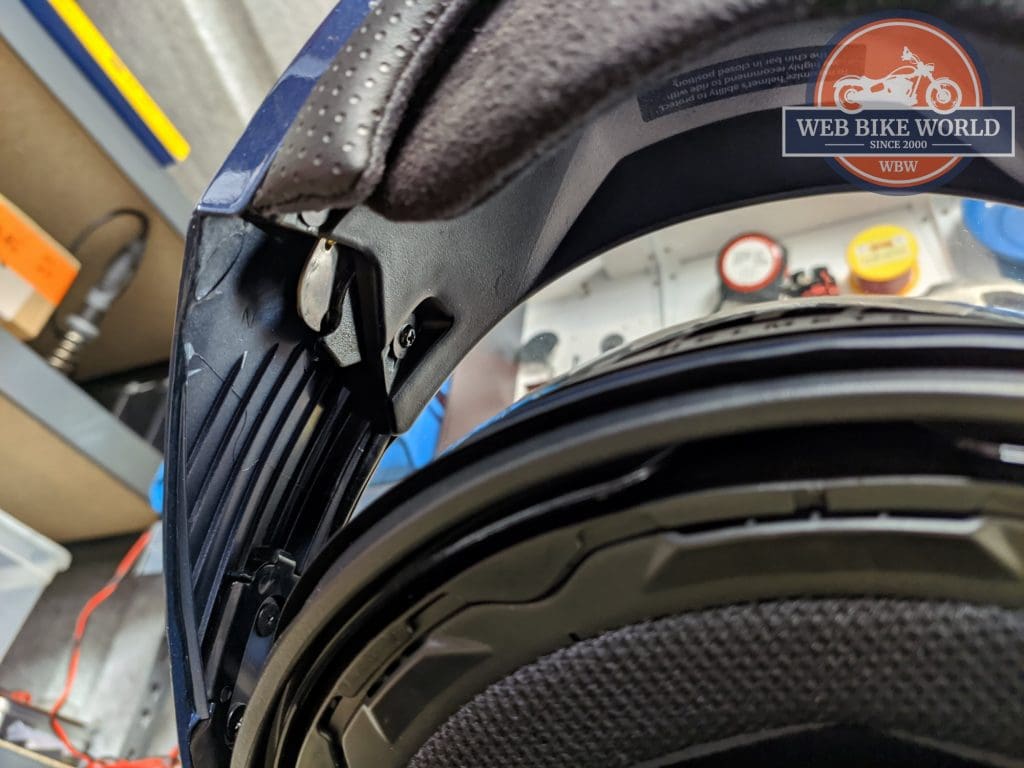 |
|---|
The steel pins for the chinbar locking mechanism on the left and the inside of the chinbar.
Unlike many modular lids, this one is homologated for use in the open position, so, fears of your face closely inspecting the road notwithstanding, you can feel comfortable using it in the open position, something I found very liberating when riding around town. Visibility is fantastic, your senses are further heightened, and it just feels cooler.
However, as is to be expected, the chinbar does act as a sail when going above 60mph but it’s easy to just reach up and close it down. My one issue with the chinbar is that I’d rather the release switch require a little more effort to pull. While virtually impossible to accidentally pull, given it is under the chin, if the switch was a little heavier it would add to the overall high-quality feel of the chinbar.
Visibility
I suppose it’s obvious that the i90 would have good visibility with the chinbar in the open position but visibility is excellent with it closed too. The visor aperture feels slightly wider than usual and, even with the removable nose/breath deflector in place, you can easily glance from your speedometer to the road, and to the sky, without having to actually move your head.
In comparison with its predecessor, the IS-MAX II, the i90 has a larger visor aperture with the helmet shell allowing for more visibility above the eye line, while the visor itself is optically correct, blocks out 99% of UV rays, and is ready for a Pinlock 70 Max Vision anti-fog lens (which is supplied in the box in some markets). The Pinlock works well, especially in wet climates such as we have in Ireland, although I think the large chin vent, combined with the small removable visor guard which deflects your breath from the visor, would do the job in less demanding conditions.
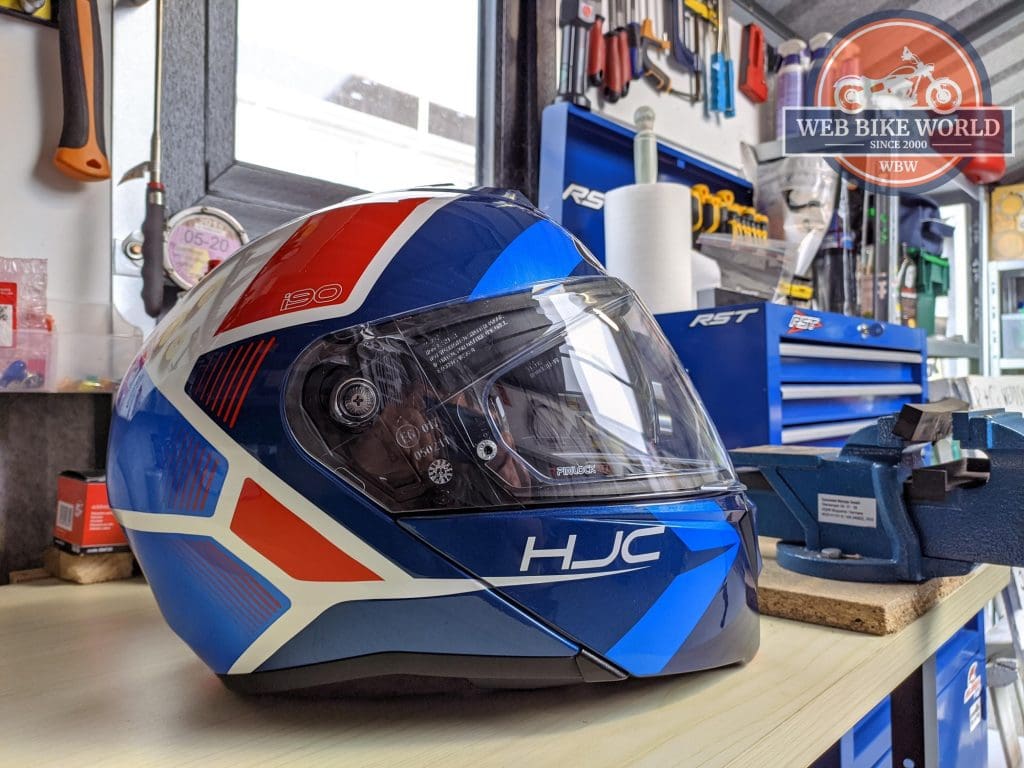
Unfortunately, every time I go to open the visor on the helmet, I feel like I’m going to break something. Although the visor itself feels like a quality item, with dual opening tabs which make it easy to open with either hand, it’s held closed by a tiny tab on the bottom center of the visor aperture.
Unlike other HJC models, there’s no rocker button to open the tab so you just have to pull the visor free, and in doing so you’ll notice there aren’t really any steps on the visor mechanism. It’s either fully closed, fully open, or almost fully closed. This isn’t a lot of choices and, sometimes, depending on wind conditions, the helmet likes to make the choice for you by snapping the visor shut at speeds above 60mph. While this is disconcerting the first time it happens, it is better than the alternative of the visor becoming a sail or being pulled right off of its hinges, as happened to me with a budget helmet years ago (apologies to the taxi driver behind me who thought he had seen an unidentified flying object).
With the visor closed and clamped in by that tab, there are no annoying air draughts or any of the high-pitched whistle sounds which can plague modular lids, but the visor seal does let the odd drip of rainwater through if conditions are particularly bad. Funnily enough, this has only happened on my Deauville/NT700v which is fully faired and, thus, the air isn’t pushing onto the visor to augment its seal – rain hasn’t gotten past the seal when I’m riding my VFR as my head is exposed to the rushing air due to the lower fairing. It’s hard to test but I imagine the visor is pushed further into the seal.
Thankfully, rainwater does not get through any of the modular mechanism openings and given that the odd drip of rainwater only ever falls from the very center of the upper visor seal, and on one bike in particularly bad conditions, perhaps I just need to remove and reseat the visor. This is made very easy by HJC’s tried and tested RapidFire visor change system – you just open the visor to the fully open position and pull down the tabs on the left and right to release the visor from the helmet.
Testing this out, I have been able to remove and refit the visor in a matter of seconds and I much preferred this mechanism to my former Shark Skwal’s system where you literally pulled the visor from the helmet, a forceful system that caused visor tabs to break on early iterations of that helmet. According to retailers dealing with both brands, they’ve never had to return a helmet to HJC over a visor issue.
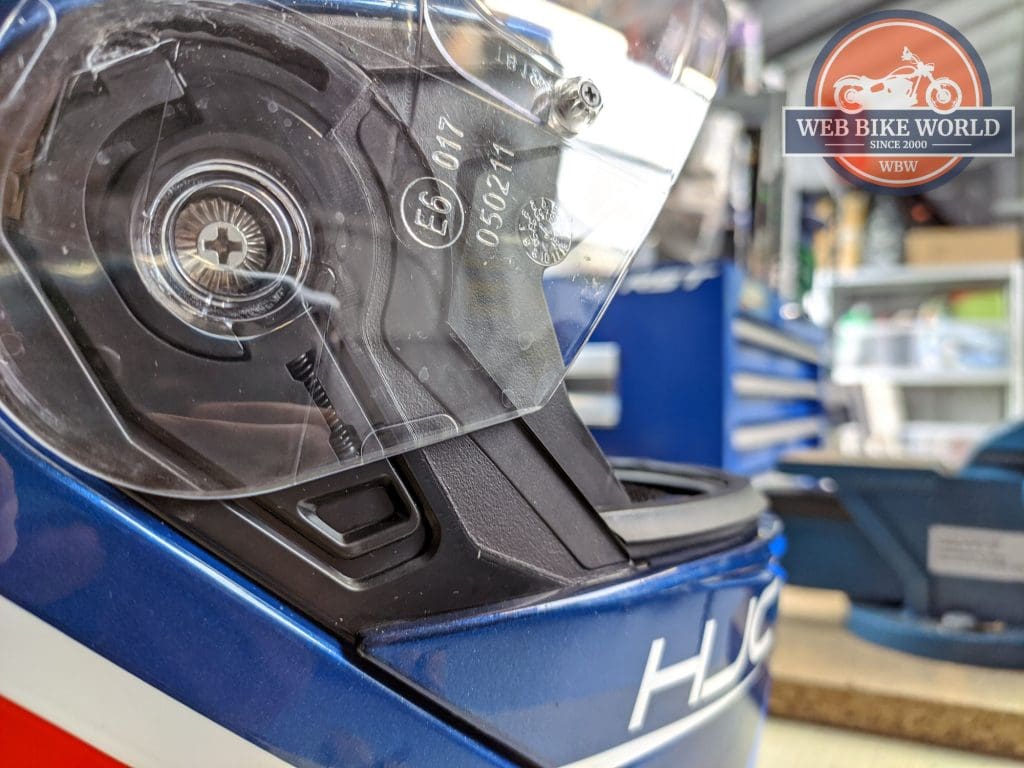


However, I haven’t been brave enough to remove and refit the sun visor which, despite decent illustrations in the i90s comprehensive user manual, looks like a real pain to do. It’s a decent sun visor, it’s dark enough to make a real difference and falls just about low enough to cover most of the visor, although with the angle I sit at the speedometer and other gauges never seem to be covered by it! There’s also no anti-mist coating on the sun visor so you end up relying on the chin vent to direct air upwards to keep it clear if it’s rainy or humid.
Realistically, I’m nitpicking here and I remain adamant that integrated sun visors are an excellent safety feature that gives you the ability to dramatically improve the quality of your vision in various light conditions.
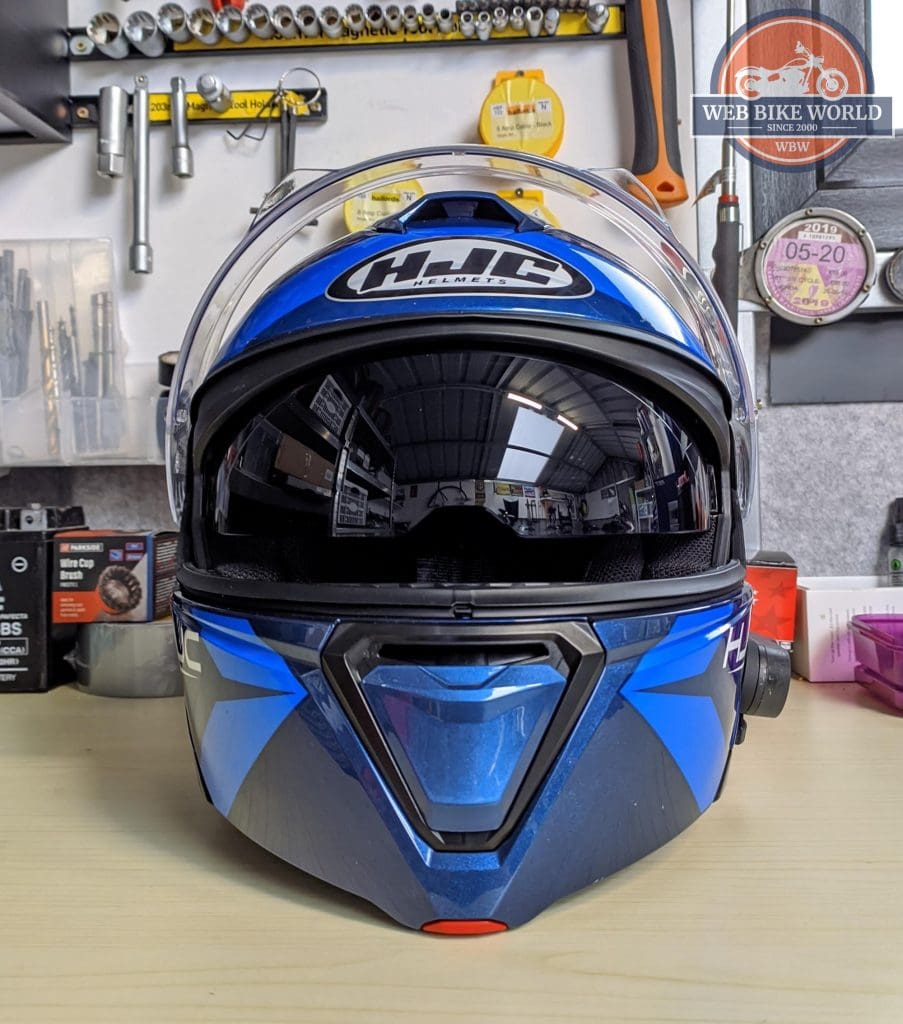   |
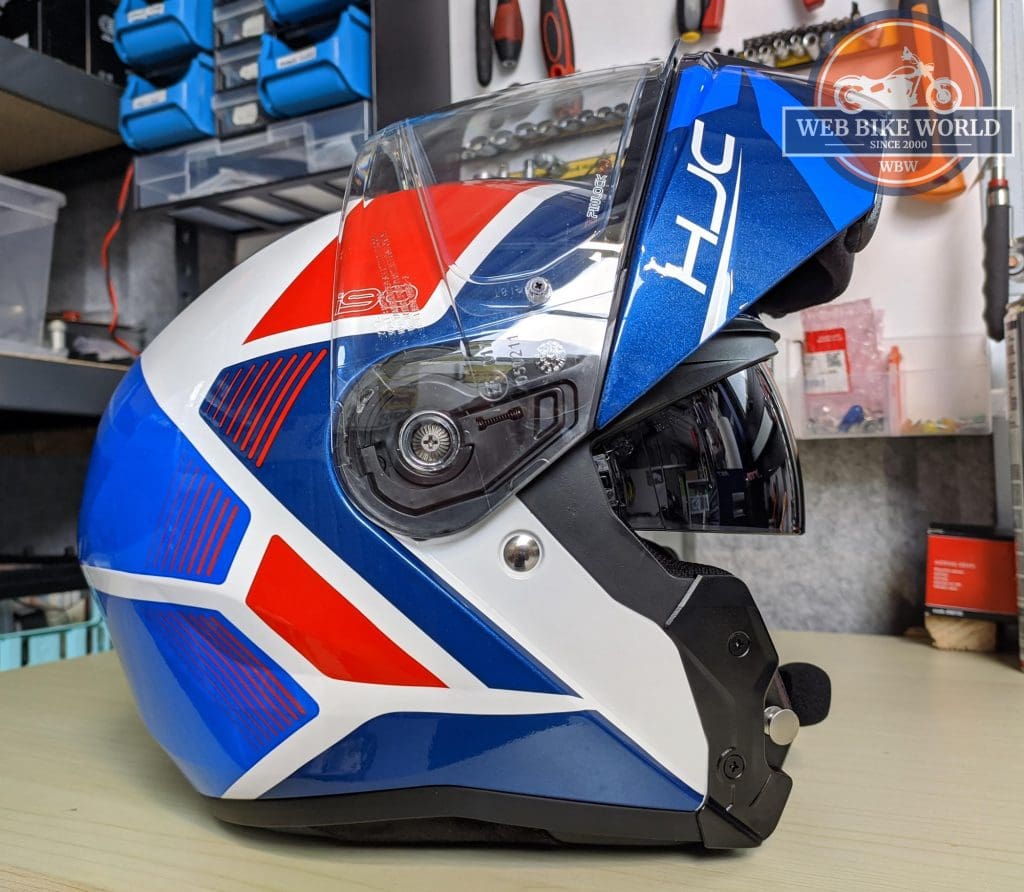   |
|---|
The internal sun visor is fairly dark and provides decent coverage, even with the chinar open.
Noise and Ventilation
As mentioned above, the chin vent does a great job directing air upwards across the main visor, or the sun visor, helping to keep both clear of misting and keeping the rider’s face relatively cool. The single crown vent is large enough to easily operate even with the thickest of winter gloves (not the easiest test in a heatwave but I have tried!) and does an admirable job at scooping fresh air through the top of the helmet.
However, riding with both vents open can become somewhat tiresome as they turn a relatively quiet helmet into something a good deal louder. I always advocate riding with earplugs to protect your hearing, and there are many variables that affect whether a helmet is perceived to be loud or quiet, but the difference between having the vents open or closed is very noticeable and not something I have experienced on other helmets.
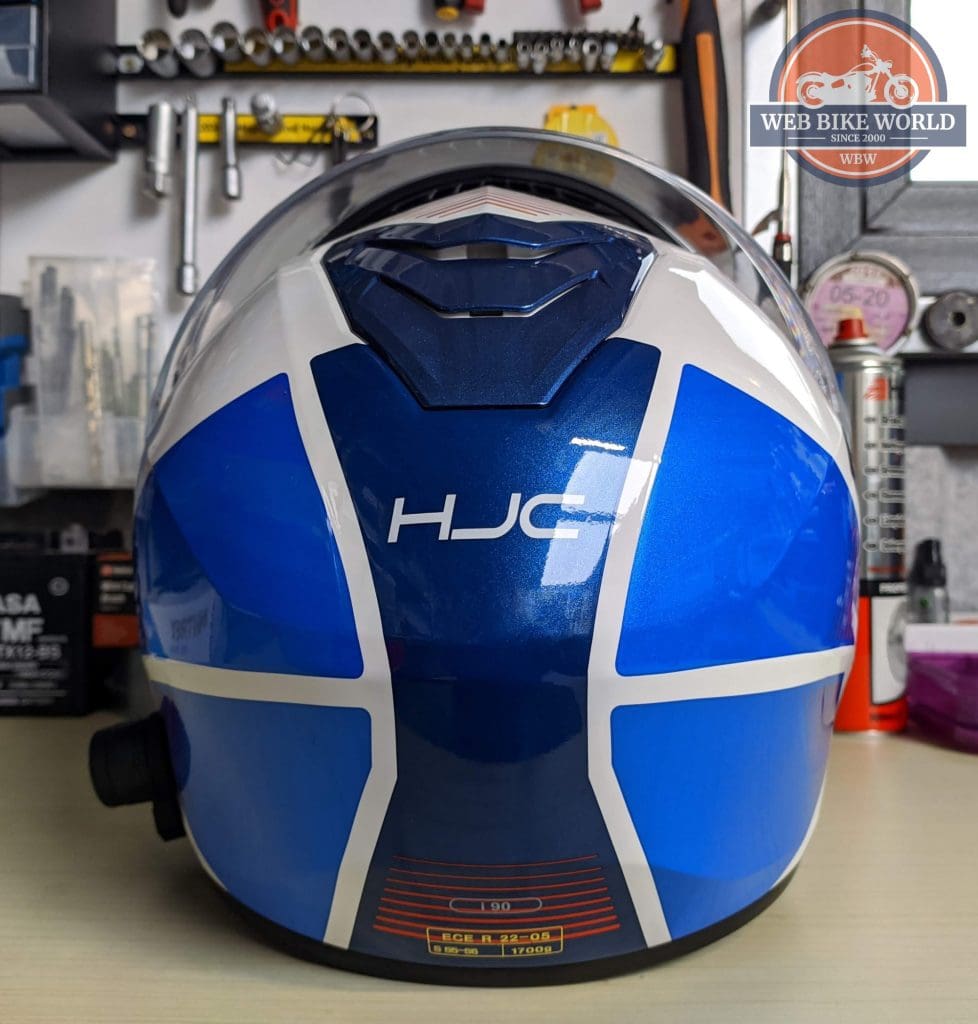


That said, ride with the vents closed, or just the chin vent open, remind yourself of the price and the fact it is a modular lid, and prepare to be surprised by how quiet it is. Modular lids, due to the fact the chinbar can disengage from the shell and flip-up, had a reputation for being noisier than standard full-face helmets. Not only could air draughts work their way in through the seals between the chinbar and the shell, but the extra bulk to contain the mechanisms for the chinbar resulted in a shape ill-defined for quietness.
Not so with the i90, which, as discussed earlier, is no bigger than an equivalent full-face lid. The smooth shell shape might remind you of some Arai lids with their rounded exterior, and while Arai says this is to help a helmet glance off of solid objects in a crash, it’s also perfect for helping keep noise levels down. With no extraneous moldings or accessories, the air can flow past the helmet without causing unnecessary aerodynamic vortices which contribute to wind noise.
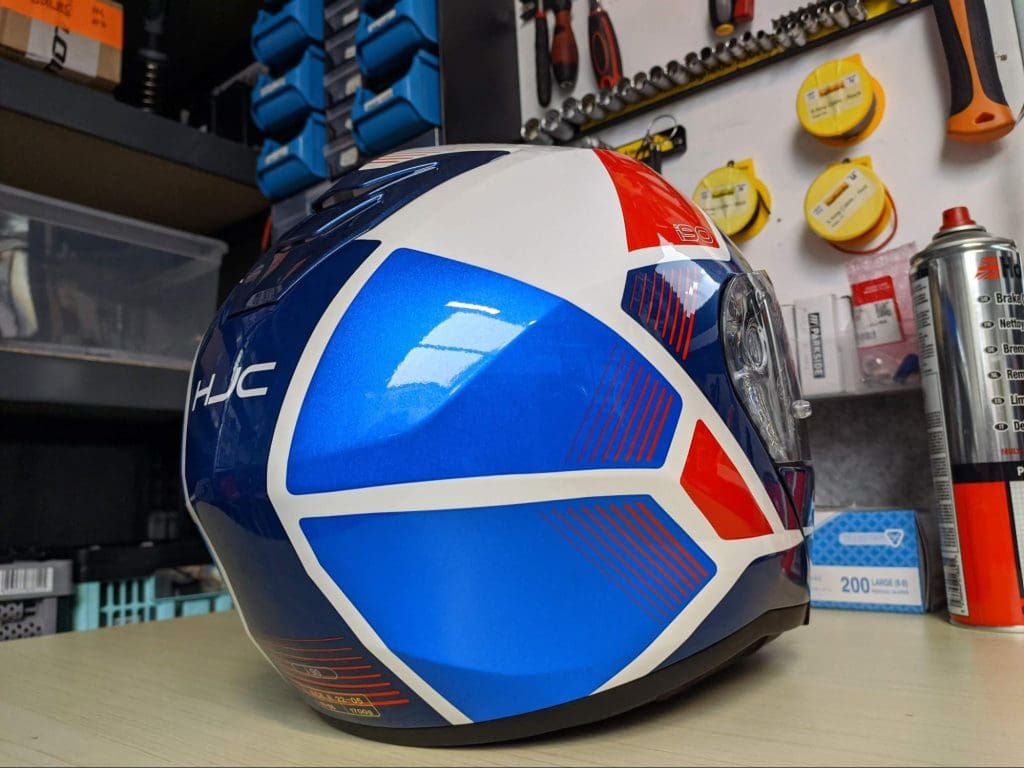


This means that, even at motorway speeds over 70mph/120kph, I found the i90 to be a quiet helmet, not just for a modular helmet but for any helmet. Indeed you can easily listen to a podcast if plodding along on your commute. Some of this is attributable to the smooth exterior and some is attributable to that beautiful interior lining which acts almost like a neck curtain, encasing the bottom of your head, dampening sound from this area of the helmet.
The lining creates quite a small aperture for your head to fit through initially but it guarantees that, even on a cold day, you won’t feel a breeze rising up from your lower neck bringing with it not just cold air, but unwanted sound too. The removable chin curtain also plays a role, the suede-like material extends back as far as the latest Shoei lids, cutting down on wind noise from the front of the helmet. These all seem like fairly simple methods of reducing wind noise, but they seem to really work on the i90.
In Conclusion
The HJC i90 is proof of just how far modular helmets have come over the last 10 years with very few compromises being made to ensure this helmet comes in at a reasonable price point. Some riders might opt to have this helmet as one they will use around town, and, if anything, those riders would actually be selling it short for this is a helmet that you could easily wear on cross-country rides, not just cross-city commutes.
Apart from a longer than expected bedding-in period, it’s a very comfortable helmet, has a solid and reliable chinbar mechanism, good ventilation and noise suppression, and looks brilliant too. Should you allow the slightly annoying visor mechanism and the odd drop of rainwater to be deal-breakers? No, they’re not significant or consistent enough issues to stop you from enjoying an excellent helmet. Are there better and lighter helmets out there? Yes, but I can’t think of any which are worth paying double the money for, and that is a verdict in and of itself.
Final Score: 4/5 stars
Pros
- The quality of paint and graphics is very high with a huge variety available.
- A wide eye port gives excellent visibility from the visor.
- Chinbar mechanism is reassuringly strong and easy to use.
- Vents are simple to use and work well.
- Homologated for use with chinbar open or closed which adds reassurance when using as an open-face lid.
Cons
- Bedding-in time was longer than other helmets I have owned.
- No option for a double-D ring fastener.
- Sunvisor switches can be hard to find and use when wearing thick gloves.
- Aftermarket intercoms have to be mounted further back to accommodate the sun visor switch.
Tech Specs
- Shell material: Advanced polycarbonate
- Weight: 1700g (size small)
- Made in: Vietnam
- Safety ratings: ECE and DOT (sizes 3XL – 5XL are DOT approved only). UK-based
- SHARP test is upcoming.
- Available sizes: XS – XXXL (up to 5XL in the US)
- Colors: 7 solid colours (including a fluorescent option) / 9 graphics options
- Price: White: ~ $210/€200/£190 / Graphics: ~$220/€230/£210
Important Links


